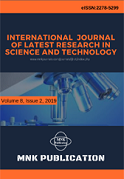DOI:10.29111/ijlrst ISRA Impact Factor:3.35, Peer-reviewed, Open-access Journal
Research Paper Open Access
International Journal of Latest Research in Science and Technology Vol.4 Issue 3, pp 19-22,Year 2015
Correspondence should be addressed to :
Received : 09 June 2015; Accepted : 22 June 2015 ; Published : 30 June 2015

| Download | 125 |
|---|---|
| View | 185 |
| Article No. | 10519 |
Purpose: The purpose of the authors was to report the first case of ciliated protozoa diagnosed in corneal scrapings from keratitis from a hydrophilic contact lens wearer. Methods: The laboratorial research confirmed polymicrobial contamination with bacteria, fungi and protozoa. The results: A 27-year-old Brazilian woman was presented in the ophthalmology ambulatory with complaints of red eye, foreign body sensation, tearing and decreased visual acuity in the left eye during the use of hydrophilic contact lenses. A ciliated protozoan suggestive of Balantidium coli was found in the examination of corneal scrapings (Giemsa). Trophozoites of the ciliated protozoa were also observed in the direct examination and culture of the lens solution, while Acanthamoeba trophozoites were diagnosed only in the culture of the solution. The other agents were diagnosed by culture of material collected from the affected cornea and contact lens. Conclusion: it is necessary to consider ciliated protozoa as potential contaminants of solutions for hydrophilic contact lenses and possible infectious agents of the cornea since there are no reports in the literature of this fact.
Copyright © 2015 Francisco Irochima Pinheiro et al. This is an open access article distributed under the Creative Commons Attribution 4.0 International (CC BY 4.0) license which permits unrestricted use, distribution, and reproduction in any medium, provided the original work is properly cited.
Francisco Irochima Pinheiro, Adriana dos Santos Forseto, Walton Nos?, Ac?cio Alves de Souza Lima Filho , " Corneal Infestation By Ciliated Protozoa?first Case Report ", International Journal of Latest Research in Science and Technology . Vol. 4, Issue 3, pp 19-22 , 2015

MNK Publication was founded in 2012 to upholder revolutionary ideas that would advance the research and practice of business and management. Today, we comply with to advance fresh thinking in latest scientific fields where we think we can make a real difference and growth now also including medical and social care, education,management and engineering.

We offers several opportunities for partnership and tie-up with individual, corporate and organizational level. We are working on the open access platform. Editors, authors, readers, librarians and conference organizer can work together. We are giving open opportunities to all. Our team is always willing to work and collaborate to promote open access publication.

Our Journals provide one of the strongest International open access platform for research communities. Our conference proceeding services provide conference organizers a privileged platform for publishing extended conference papers as journal publications. It is deliberated to disseminate scientific research and to establish long term International collaborations and partnerships with academic communities and conference organizers.